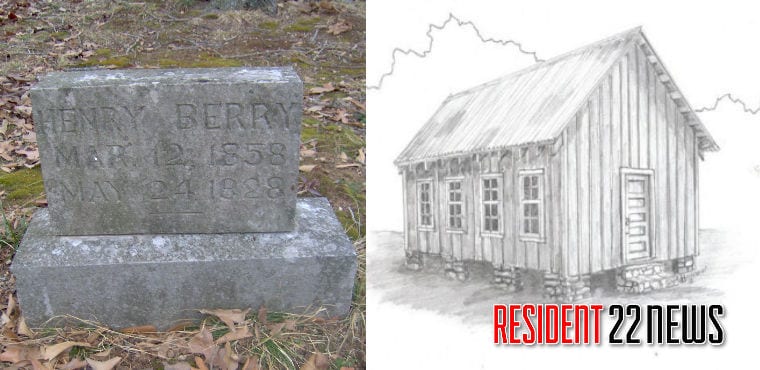By Jack James
For several years, I have been interested (maybe even obsessed) by the area of Utah Ranch Road that is the location of a group of graves known locally as the Red Oak Cemetery. In the early 1900s, it was also the location of the Red Oak Church. This wood framed, one room structure was also used as a school for area black children. The building is no longer there having been torn down before almost anyone’s memory. No photographs seem to be in existence of the building. However, from the memories of several old timers who lived in the community during that time, I drew the pencil drawing included here from their specifications. They all complimented me that it was spot on.
In 1997, a historian named Wanda M. Gray surveyed the cemetery and published her findings in a periodical in South Sebastian County. I am including it here:
To locate this century old cemetery proceed north of Lavaca on Hwy 96, to the intersection of Hwy 253 (very short distance), exit left onto Hwy 253, proceed 1.1 miles to East Utah Ranch Road, exit right, travel .3 of a mile. The burial ground is on your right. It is situated on a knoll on the back side of a large plot of ground, with numerous oak trees, and it fronts the paved road. It is fenced on three sides.
In the 1980s, when Mr. and Mrs. Ray Timms purchased the land across the road, the cemetery area was liken unto a jungle. The energetic Mrs. Ray Timms garnered the help of her husband and they braved the poison ivy, saw briars, heavy ingrowths, and small trees, and today this historic burial site is neatly kept.
Miss Euneva Piercy, retired school teacher, grew up on her father’s farm across the road and recalled the one-room building that was used for both a school and a church. It was used by approximately fifty African American families of the community who helped to work the fertile farm land of the area. She moved there around 1917, and acknowledges that, at this time [1997], it had been established for many years. Further, she commented that the people of this community were industrious, honest and highly respected citizens. It is evident from the inscriptions on the monuments that these people had deep religious beliefs.
The earliest recorded burial is in 1890; however, as there are tombstones on one end of the graveyard, a large open space in the middle, and tombstones on the opposite end, it is highly likely that burials could have occurred much earlier. The last burial was in 1935, Manda Caldwell, and the neighbors recalled that Mr. Bill Caldwell, used to visit the Caldwell graves. Mr. Caldwell is now deceased and buried in another location.”
Mrs. Gray also provided a list of the deceased buried there along with the inscriptions on the tombstones. Here are those names: Amos Berry, Henry Berry, Henry O. Berry, Leona Berry, Henry Boudry, Elbert West Brook, Henry O. Brook, Mary West Brook, Clarence Caldwell, Emma Caldwell, Manda Caldwell, D. R., Alice Driver, Joe Driver, Remos Driver, M. G., Maudie Homes, Virginia Homes, Kaodus McDaniel, Irene Murry, Marie Shepard, Charles Taylor, Sophy Taylor.
Beginning in 1920, the Bugscuffle, Moore’s Rock, Arbuckle Island and other area schools, consolidated with Lavaca. The Red Oak School joined in the consolidation movement in 1936. An agreement between Barling and Lavaca called for Barling to take Lavaca’s black pupils to a school in Barling, and in return, Lavaca would take Barling’s high school students. Education comes to an end in the Red Oak area of Lavaca.
A few stories have trickled in making the people who shared Lavaca with us so many years ago more real. For example, the segregation of the early 1900s kept blacks and whites apart. Mr. Caldwell, mentioned earlier, couldn’t attend the churches in the area. People say that he would sit on the back steps of the Baptist Church and listen to the sermons and pray with the congregation alone.
Several of the elder citizens remember how some of the residents of the Red Oak area worked as domestic help in area homes. Stories of Aunt Lottie and Aunt Lucy became like family to area citizens. I have heard from more than one person that Aunt Lucy was a wet nurse to some area white children.
There are good stories too. One is of Ravin Caldwell, son of James Caldwell of Lavaca. He played football for Northside High School in Fort Smith and went on to play professional football.
Several men have told me the stories of the wonderful picnics they would have in the yard beside the Red Oak Church for occasions such as July 4th celebrations. Area black and white boys played baseball side-by-side on a baseball field on the property as well.
The history of this area of our community continues to reveal more every day. This history lesson is far from over.







